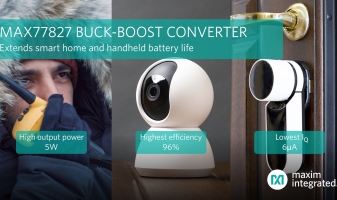Maxim power management solution claims to set industry’s standard to boost runtime of portable devices

With the lowest quiescent current (IQ) in its class of 6µA, as well as the highest peak efficiency of 96% in the market, designers can now maximise a portable device’s battery life with the MAX77827 buck-boost converter from Maxim Integrated Products, Inc.
This 1.5A high-efficiency, compact converter allows 1.8V to 5.5V input and 2.3V to 5.3V output, while providing the system stability needed to minimise abrupt or unexpected shutdowns. The MAX77827 addresses the power requirements of low-power wide-area network (LPWAN) applications, asset tracking devices and many Internet of Things (IoT) applications.
The growing lithium-ion battery market is largely driven by an increasing inclination towards smart electronic devices with expanding functionalities packed within. Primary cell batteries based on Lithium Thionyl Chloride (Li-SOCl2) chemistry or dual-cell Alkaline (AA or AAA) with operations as low as 1.8V is also gaining popularity in the long-life portable market segment.
However, regardless of the types of batteries used, these devices will discharge through a wide range of voltages while sustaining a power rail between 2.8V to 3.8V, specifically for powering MCU, Wi-Fi, BLE and GPS features. The traditional buck or bypass boost plus low dropout (LDO) topologies are not ideal solutions for these sophisticated devices because they are not the most efficient at prolonging battery life. Additionally, a simple buck converter topology may cause earlier system shutdown when battery voltage is high to maintain the required power for the aforementioned applications, leaving underutilised battery capacity.
With the lowest quiescent current in the market, highest efficiency gains and small solution size, the MAX77827 buck-boost converter sets the standard for maximising battery life. It is an ideal solution to support applications with low power requirements because, regardless of the battery voltage variations, it can automatically transition between buck and boost modes to provide a consistent output power supply.
Compared with the current means of utilising a bypass boost converter followed by an LDO, the MAX77827 improves efficiency by up to 12%. Compared with utilising a buck converter, it allows continuous system operation with lower voltage from the battery to further utilise the battery capacity. The MAX77827 is the latest buck-boost converter in Maxim’s portfolio.
Key advantages
- Longer battery life: offers lowest quiescent current in its class of 1.5A buck-boost converters at 6µA (81% lower than closest competitor) and prolongs battery run-time for applications that run as low as 1.8V. It features 96% system efficiency regardless of buck or boost modes and is consistently superior across the load range versus closest competitor.
- Better system stability: provides system stability to minimise abrupt or unexpected shutdown, including fast line transient response for a seamless mode transition between buck and boost modes to keep systems running steadily. During mode transition when VOUT is set to 3.3V with a 15µs rise/fall time, the ripple is less than 1% of the output voltage. Fast load transient response provides stable system voltage from transient loads pulling down the system voltage. In extreme harsh conditions of going from 0A to 1A load in 15µs, MAX77827 undershoot is controlled to 6% of the output voltage where the undershoot of the competitive solution is 12% with a longer recovery time.
- Small form factor: supports space-constrained designs with its 2.04mm x 1.64mm WLP size and less than 15mm² total solution size. It features a single external resistor to set the output voltage to provide additional savings to an external component and board space.
“High adoption of lithium ion batteries in smart consumer electronics is driving the increasing demand for this market, which is projected to reach $106,493 million by 2024,” said Rishab Sharma, analyst for P&S Intelligence. “Complimentary technologies that help prolong battery life and stability can only contribute to their continued growth.”
“For any system design where battery life is critical, there is no better solution than the MAX77827,” said Eric Pittana, director for Mobile Power Solutions at Maxim Integrated. “With the lowest quiescent current and highest efficiency, designers can truly optimise their solutions and maximise their system performance. Specifically, for applications such as GPS asset tracking devices with single-use discharge, prolonging battery life is essential.”
Comment on this article below or via Twitter @IoTGN
